【BBC六分钟英语】是什么让视频走红?

【英文脚本】
Neil
Hello. I’m Neil. Welcome to 6 Minute English, where we like to share…
Rob
Jokes, funny stories and cat videos…
Neil
No, Rob, we like to share six useful items of vocabulary.
Rob
Yes, that too. But first, check out this meme on my phone, Neil, Grumpy Cat, it’s so cute! Shall I send it to you?
Neil
No, please don’t! A meme is a picture or video with an amusing caption that a lot of people share with each other online. Well, in this programme we’re talking about why some online content goes viral…
Rob
… and some doesn’t. This cat is cute because it looks so grumpy, and that means ‘bad tempered’
Neil
An image, video, or other piece of information goes viral when it gets passed on very quickly from person to person on the internet.
Rob
So first let’s start with our quiz question, Neil. Can you tell me which was one of the first videos to go viral on the internet? Was it… a) Charlie Bit my Finger, b) Sneezing Panda or c) Dancing Baby?
Neil
I’m going to guess ‘Sneezing Panda’, because I haven’t seen any of those videos.
Rob
That’s ridiculous Neil. Have you been living under a rock?
Neil
Look, I just don’t find silly videos particularly cute, or funny.
Rob
OK, OK, no need to get grumpy about it. Let’s move on. Why do so many people, Neil excluded, enjoy sharing content online? Let’s listen to Dr Jonah Berger, Marketing Professor at the University of Pennsylvania and author of Contagious: Why things catch on, talking about what motivates us to share.
Dr Jonah Berger, Marketing Professor at the University of Pennsylvania and author
Humans are social animals. Sharing allows us (to) feel connected to others. We share emotions, which allow us to deepen the bonds we have with our peers and with our friends.
Neil
So it’s all about being connected and deepening the bonds between ourselves and our peers. Our peers are people the same age as ourselves who share the same social position in a group.
Rob
And we particularly like to share content that makes us feel emotional. Let’s hear more from Dr Jonah Berger about this.
Dr Jonah Berger, Marketing Professor at the University of Pennsylvania and author
High arousal emotions include things like anger and anxiety, but also excitement and humour, low arousal, sadness and contentment. [It] turns out that those high-arousal emotions, those emotions that fire us up and cause us to take action, also drive us to share.
Neil
Arousal means ‘to excite a particular feeling in somebody’. And emotions like anger and anxiety tend to cause stronger feelings than sadness and contentment.
Rob
Right, high-arousal emotions fire us up, and to fire someone up means ‘to make someone excited and enthusiastic about something’. So when a video we see on the internet makes us laugh, or makes us excited or angry, then we are more likely to share it with others.
Neil
And sharing that emotion with others strengthens the connection or bond between us. That’s what Dr Berger’s theory says anyway.
Rob
I’m surprised that sad things aren’t passed on as much as, say, funny things.
Neil
Well, how often do you share sad videos with your peers?
Rob
Good point. I do tend to share content that makes me laugh, more than sad or angry stuff anyway. Like the Grumpy Cat meme. Can I show it to you now?
Neil
No.
Rob
OK. I’ll just show you the caption. It says, “I purred once. It was terrible”.
Neil
Yeah. Right. Hilarious, Rob. Now, can we have the answer to today’s quiz question, please, if you’ve finished amusing yourself?
Rob
OK. OK. Which was one of the first videos to go viral on the internet? Was it… a) Charlie Bit my Finger, b) Sneezing Panda or c) Dancing Baby?
Neil
And I said ‘Sneezing Panda’.
Rob
Well, it was actually Dancing Baby. This 3-dimensional animation of a baby dancing the cha- cha was one of the first viral videos released in the late 1990s. Another popular one was the Hamster Dance by Hampton the Hamster, which appeared in 1997.
Neil
Well, fascinating as all that sounds, shall we look back at the words we learned today, Rob?
Rob
Sure. The first item was ‘meme’, a picture or video with an amusing caption that a lot of people share with each other online. For example, “I tried to show Neil a hilarious meme about a grumpy cat.”
Neil
The word ‘meme’ was actually invented by evolutionary biologist Professor Richard Dawkins to represent an idea or concept that spreads in human culture in a similar way to a gene.
Rob
Fascinating. That sounds way too complicated, Neil. Let’s move on to item number two – ‘grumpy’, I gave one example just now. But here’s another one: “He’s the grumpiest man I’ve ever met.”
Neil
I hope you’re not talking about me, Rob. Number three, ‘to go viral’, means ‘an image, video, or other piece of information that gets passed on very quickly from person to person on the Internet’. For example, “What makes a video go viral?”
Rob
I don’t know, Neil, If I knew how to make a viral video, I’d be a rich man by now!
Neil
Before computers and the internet we only talked about viral infections, didn’t we? “I’ve got a nasty viral infection so I’m not coming into work today.”
Rob
Yeah, that’s right. The connection is that both viral infections and viral memes spread quickly!
Neil
OK, number four. ‘Peers’ are people the same age as our selves who share the same social position in a group.
Rob
For example, “Teenagers often worry about looking silly in front of their peers.” Next up – arousal, that means ‘to excite a particular feeling in somebody’.
Neil
We heard about high and low-arousal emotions. The verb is ‘to arouse’. For example, “The debate aroused strong feelings on both sides.”
Rob
OK, finally, ‘to fire someone up’ means ‘to make someone excited and enthusiastic about something’. “I’m really fired up about today’s vocabulary!”
Neil
Good to know, Rob. But it’s time to go now, but please check out our Instagram, Twitter, Facebook and YouTube pages.
Rob
Bye-bye!
Neil
Goodbye!
Rob
Shall we watch that ‘Dancing Baby’ now, Neil?
Neil
No.
【中英文双语脚本】
Neil(尼尔)
Hello. I’m Neil. Welcome to 6 Minute English, where we like to share…
你好。我是 Neil。欢迎来到 6 Minute English,我们想在这里分享……
Rob(罗伯)
Jokes, funny stories and cat videos…
笑话、有趣的故事和猫咪视频……
Neil(尼尔)
No, Rob, we like to share six useful items of vocabulary.
不,罗伯,我们想分享六个有用的词汇。
Rob(罗伯)
Yes, that too. But first, check out this meme on my phone, Neil, Grumpy Cat, it’s so cute! Shall I send it to you?
是的,也是这样。但首先,看看我手机上的这个模因,Neil,Grumpy Cat,它太可爱了!我把它寄给你好吗?
Neil(尼尔)
No, please don’t! A meme is a picture or video with an amusing caption that a lot of people share with each other online. Well, in this programme we’re talking about why some online content goes viral…
不,请不要!模因是很多人在网上相互分享的带有有趣标题的图片或视频。好吧,在这个节目中,我们谈论的是为什么一些在线内容会像病毒一样传播……
Rob(罗伯)
… and some doesn’t. This cat is cute because it looks so grumpy, and that means ‘bad tempered’
…而有些则没有。这只猫很可爱,因为它看起来脾气暴躁,意思是“脾气暴躁”
Neil(尼尔)
An image, video, or other piece of information goes viral when it gets passed on very quickly from person to person on the internet.
当图像、视频或其他信息在互联网上迅速地在人与人之间传递时,它就会传播开来。
Rob(罗伯)
So first let’s start with our quiz question, Neil. Can you tell me which was one of the first videos to go viral on the internet? Was it… a) Charlie Bit my Finger, b) Sneezing Panda or c) Dancing Baby?
所以首先让我们从我们的测验问题开始,Neil。你能告诉我哪个是最早在互联网上传播的视频之一吗?是不是……a) Charlie Bit my Finger,b) Sneezing Panda 或 c) Dancing Baby?
Neil(尼尔)
I’m going to guess ‘Sneezing Panda’, because I haven’t seen any of those videos.
我猜是《打喷嚏的熊猫》,因为我还没看过那些视频。
Rob(罗伯)
That’s ridiculous Neil. Have you been living under a rock?
太荒谬了,尼尔。你是否一直生活在困境中?
Neil(尼尔)
Look, I just don’t find silly videos particularly cute, or funny.
你看,我就是不觉得愚蠢的视频特别可爱或有趣。
Rob(罗伯)
OK, OK, no need to get grumpy about it. Let’s move on. Why do so many people, Neil excluded, enjoy sharing content online? Let’s listen to Dr Jonah Berger, Marketing Professor at the University of Pennsylvania and author of Contagious: Why things catch on, talking about what motivates us to share.
好吧,好吧,没必要为此发脾气。让我们继续前进。为什么这么多人(不包括 Neil)喜欢在线分享内容?让我们听听宾夕法尼亚大学营销学教授、《传染性:为什么事情流行起来》一书的作者 Jonah Berger 博士,谈谈是什么促使我们分享。
Dr Jonah Berger, Marketing Professor at the University of Pennsylvania and author(宾夕法尼亚大学市场营销学教授、作家JonahBerger博士)
Humans are social animals. Sharing allows us (to) feel connected to others. We share emotions, which allow us to deepen the bonds we have with our peers and with our friends.
人类是群居动物。分享让我们(能)感觉到与他人的联系。我们分享情感,这使我们能够加深与同龄人和朋友的纽带。
Neil(尼尔)
So it’s all about being connected and deepening the bonds between ourselves and our peers. Our peers are people the same age as ourselves who share the same social position in a group.
因此,这一切都是为了建立联系并加深我们与同龄人之间的联系。我们的同龄人是与我们同龄的人,他们在群体中拥有相同的社会地位。
Rob(罗伯)
And we particularly like to share content that makes us feel emotional. Let’s hear more from Dr Jonah Berger about this.
我们特别喜欢分享让我们感慨万千的内容。让我们听听 Jonah Berger 博士对此的更多信息。
Dr Jonah Berger, Marketing Professor at the University of Pennsylvania and author(宾夕法尼亚大学市场营销学教授、作家JonahBerger博士)
High arousal emotions include things like anger and anxiety, but also excitement and humour, low arousal, sadness and contentment. [It] turns out that those high-arousal emotions, those emotions that fire us up and cause us to take action, also drive us to share.
高唤醒情绪包括愤怒和焦虑等,但也包括兴奋和幽默、低唤醒、悲伤和满足。事实证明,那些高度唤醒的情绪,那些激发我们并促使我们采取行动的情绪,也驱使我们分享。
Neil(尼尔)
Arousal means ‘to excite a particular feeling in somebody’. And emotions like anger and anxiety tend to cause stronger feelings than sadness and contentment.
唤醒的意思是“激发某人的特定感觉”。而愤怒和焦虑等情绪往往比悲伤和满足更能引起强烈的感受。
Rob(罗伯)
Right, high-arousal emotions fire us up, and to fire someone up means ‘to make someone excited and enthusiastic about something’. So when a video we see on the internet makes us laugh, or makes us excited or angry, then we are more likely to share it with others.
是的,高度唤醒的情绪会激发我们,而 To fire someone up 的意思是 “让某人对某事感到兴奋和热情”。因此,当我们在互联网上看到的视频让我们发笑,或者让我们兴奋或生气时,我们更有可能与他人分享。
Neil(尼尔)
And sharing that emotion with others strengthens the connection or bond between us. That’s what Dr Berger’s theory says anyway.
与他人分享这种情感可以加强我们之间的联系或纽带。无论如何,Berger 博士的理论就是这么说的。
Rob(罗伯)
I’m surprised that sad things aren’t passed on as much as, say, funny things.
我很惊讶,悲伤的事情并没有像有趣的事情那样被传递出去。
Neil(尼尔)
Well, how often do you share sad videos with your peers?
那么,你多久与同龄人分享一次悲伤的视频呢?
Rob(罗伯)
Good point. I do tend to share content that makes me laugh, more than sad or angry stuff anyway. Like the Grumpy Cat meme. Can I show it to you now?
说得好。我确实倾向于分享让我发笑的内容,无论如何,比悲伤或愤怒的内容更重要。就像 Grumpy Cat 模因一样。我现在可以给你看吗?
Neil(尼尔)
No.
不。
Rob(罗伯)
OK. I’ll just show you the caption. It says, “I purred once. It was terrible”.
还行。我只给你看标题。上面写着,’我咕噜咕噜地叫过一次。太可怕了。
Neil(尼尔)
Yeah. Right. Hilarious, Rob. Now, can we have the answer to today’s quiz question, please, if you’ve finished amusing yourself?
是的。好的。搞笑,罗伯。现在,如果您已经完成了自娱自乐,我们能否获得今天测验问题的答案?
Rob(罗伯)
OK. OK. Which was one of the first videos to go viral on the internet? Was it… a) Charlie Bit my Finger, b) Sneezing Panda or c) Dancing Baby?
好的。哪个是最早在互联网上传播的视频之一?是不是……a) Charlie Bit my Finger,b) Sneezing Panda 或 c) Dancing Baby?
Neil(尼尔)
And I said ‘Sneezing Panda’.
我说’打喷嚏的熊猫’。
Rob(罗伯)
Well, it was actually Dancing Baby. This 3-dimensional animation of a baby dancing the cha- cha was one of the first viral videos released in the late 1990s. Another popular one was the Hamster Dance by Hampton the Hamster, which appeared in 1997.
嗯,它实际上是 Dancing Baby。这个婴儿跳 cha 的 3D 动画是 1990 年代后期发布的首批病毒视频之一。另一个受欢迎的是 1997 年出现的仓鼠汉普顿的仓鼠舞。
Neil(尼尔)
Well, fascinating as all that sounds, shall we look back at the words we learned today, Rob?
好吧,尽管听起来很吸引人,但让我们回顾一下我们今天学到的单词吗,罗伯?
Rob(罗伯)
Sure. The first item was ‘meme’, a picture or video with an amusing caption that a lot of people share with each other online. For example, “I tried to show Neil a hilarious meme about a grumpy cat.”
确定。第一项是“模因”,这是一张带有有趣标题的图片或视频,很多人在网上互相分享。例如,’我试图给 Neil 看一个关于一只脾气暴躁的猫的搞笑模因。
Neil(尼尔)
The word ‘meme’ was actually invented by evolutionary biologist Professor Richard Dawkins to represent an idea or concept that spreads in human culture in a similar way to a gene.
“模因”这个词实际上是由进化生物学家理查德·道金斯教授发明的,它代表以类似于基因的方式在人类文化中传播的想法或概念。
Rob(罗伯)
Fascinating. That sounds way too complicated, Neil. Let’s move on to item number two – ‘grumpy’, I gave one example just now. But here’s another one: “He’s the grumpiest man I’ve ever met.”
迷人。这听起来太复杂了,Neil。让我们继续第二项 – “脾气暴躁”,我刚才举了一个例子。但这里有另一个问题:’他是我见过的最脾气暴躁的人。
Neil(尼尔)
I hope you’re not talking about me, Rob. Number three, ‘to go viral’, means ‘an image, video, or other piece of information that gets passed on very quickly from person to person on the Internet’. For example, “What makes a video go viral?”
我希望你不是在说我,罗伯。第三点,“病毒式传播”,意思是“在互联网上非常迅速地在人与人之间传递的图像、视频或其他信息”。例如,“是什么让视频传播开来?
Rob(罗伯)
I don’t know, Neil, If I knew how to make a viral video, I’d be a rich man by now!
我不知道,尼尔,如果我知道如何制作病毒式视频,我现在已经是个有钱人了!
Neil(尼尔)
Before computers and the internet we only talked about viral infections, didn’t we? “I’ve got a nasty viral infection so I’m not coming into work today.”
在计算机和互联网出现之前,我们只谈论病毒感染,不是吗?“我感染了严重的病毒,所以我今天不来上班。”
Rob(罗伯)
Yeah, that’s right. The connection is that both viral infections and viral memes spread quickly!
是的,没错。联系在于病毒感染和病毒模因都传播得很快!
Neil(尼尔)
OK, number four. ‘Peers’ are people the same age as our selves who share the same social position in a group.
好的,第四个。“同龄人”是与我们同龄的人,他们在群体中拥有相同的社会地位。
Rob(罗伯)
For example, “Teenagers often worry about looking silly in front of their peers.” Next up – arousal, that means ‘to excite a particular feeling in somebody’.
例如,“青少年经常担心在同龄人面前显得愚蠢。接下来是 - 唤醒,意思是 “激发某人的特定感觉”。
Neil(尼尔)
We heard about high and low-arousal emotions. The verb is ‘to arouse’. For example, “The debate aroused strong feelings on both sides.”
我们听说了高唤醒和低唤醒情绪。动词是 ‘to arouse’。例如,“这场辩论激起了双方的强烈情绪。
Rob(罗伯)
OK, finally, ‘to fire someone up’ means ‘to make someone excited and enthusiastic about something’. “I’m really fired up about today’s vocabulary!”
好的,最后,“to fire someone up”的意思是“让某人对某事感到兴奋和热情”。“我真的对今天的词汇感到兴奋!”
Neil(尼尔)
Good to know, Rob. But it’s time to go now, but please check out our Instagram, Twitter, Facebook and YouTube pages.
很高兴知道,罗伯。但现在是时候出发了,但请查看我们的 Instagram、Twitter、Facebook 和 YouTube 页面。
Rob(罗伯)
Bye-bye!
再见!
Neil(尼尔)
Goodbye!
再见!
Rob(罗伯)
Shall we watch that ‘Dancing Baby’ now, Neil?
我们现在看那个“跳舞的婴儿”好吗,尼尔?
Neil(尼尔)
No.
不。

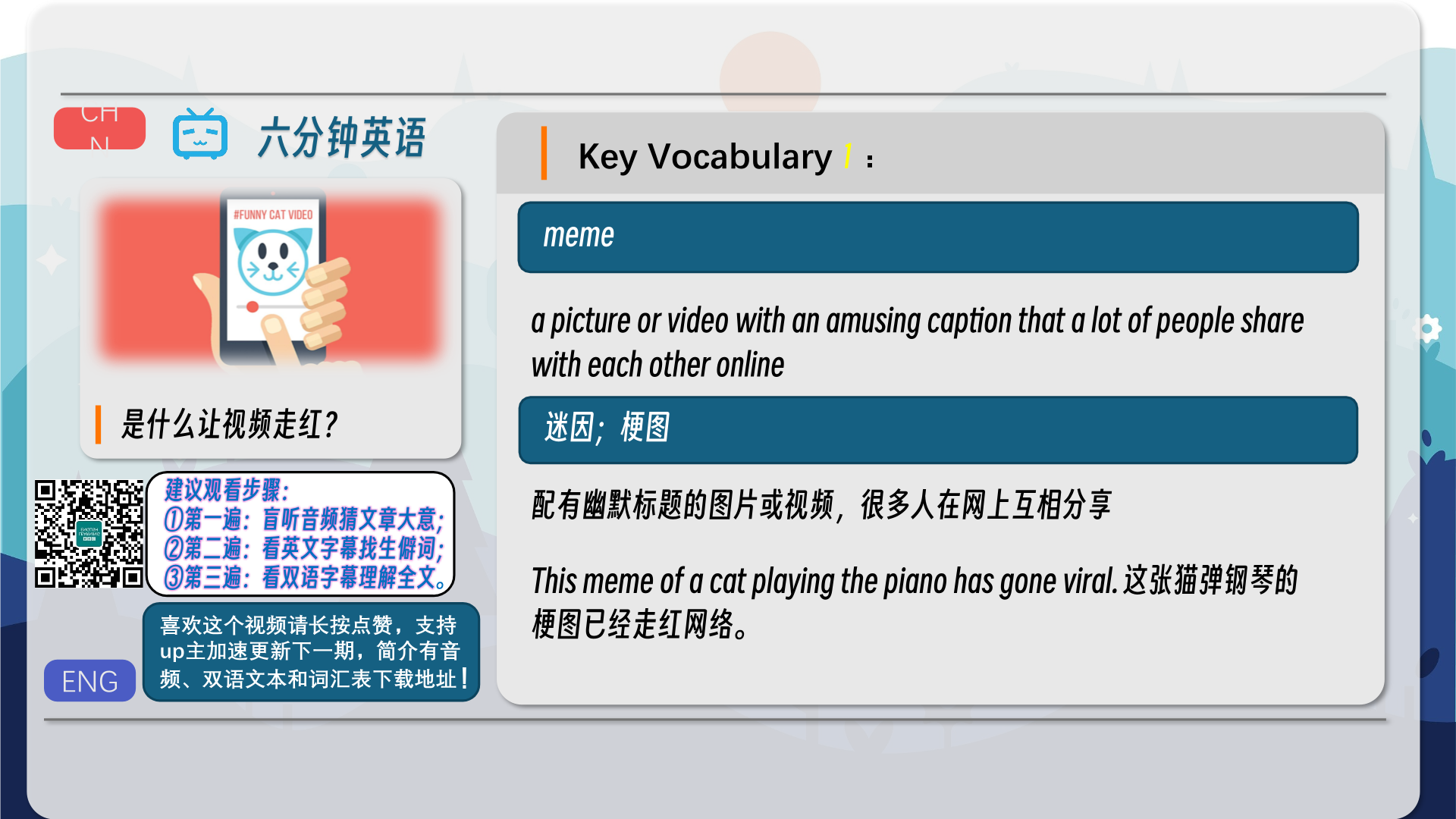

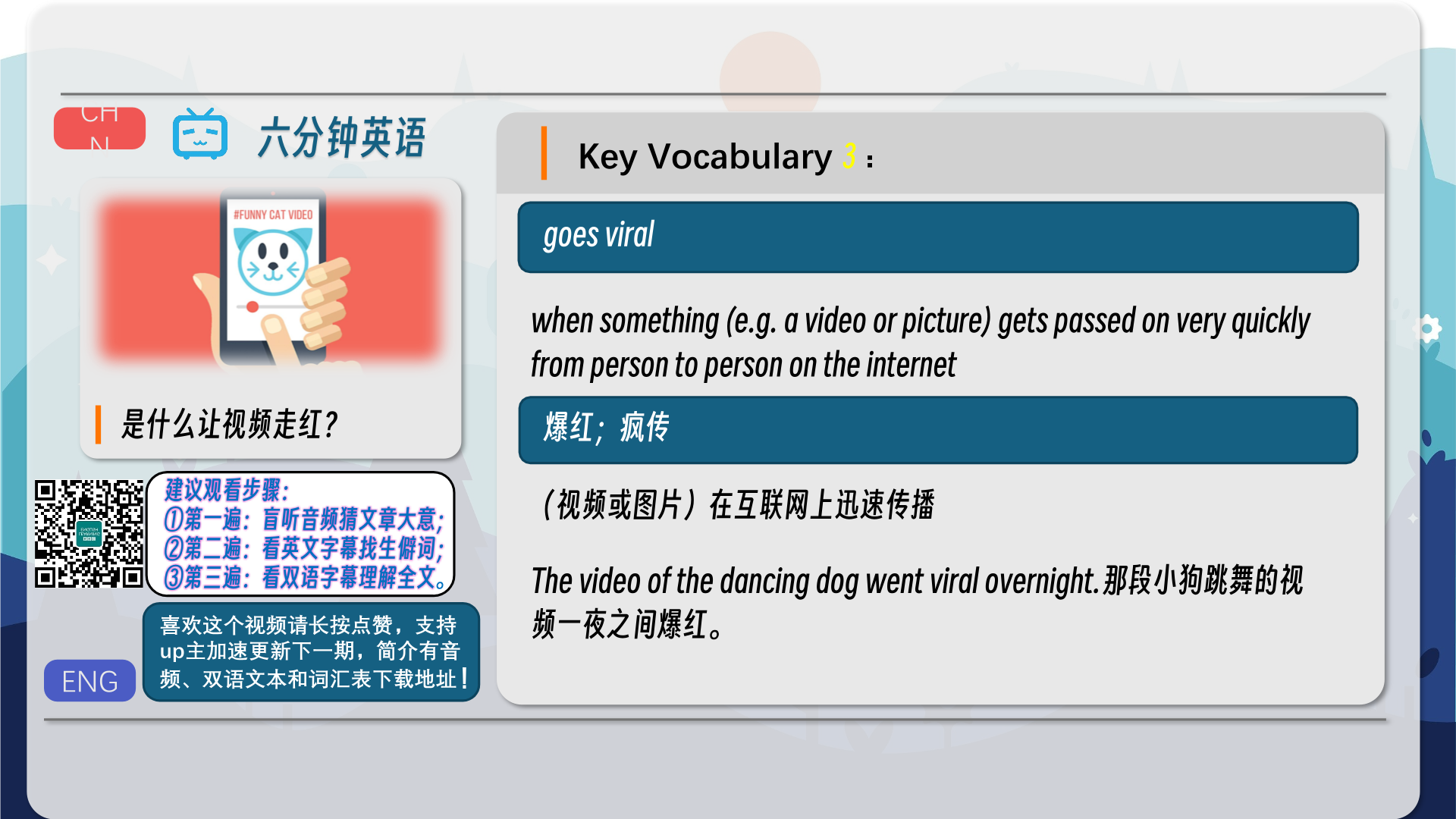
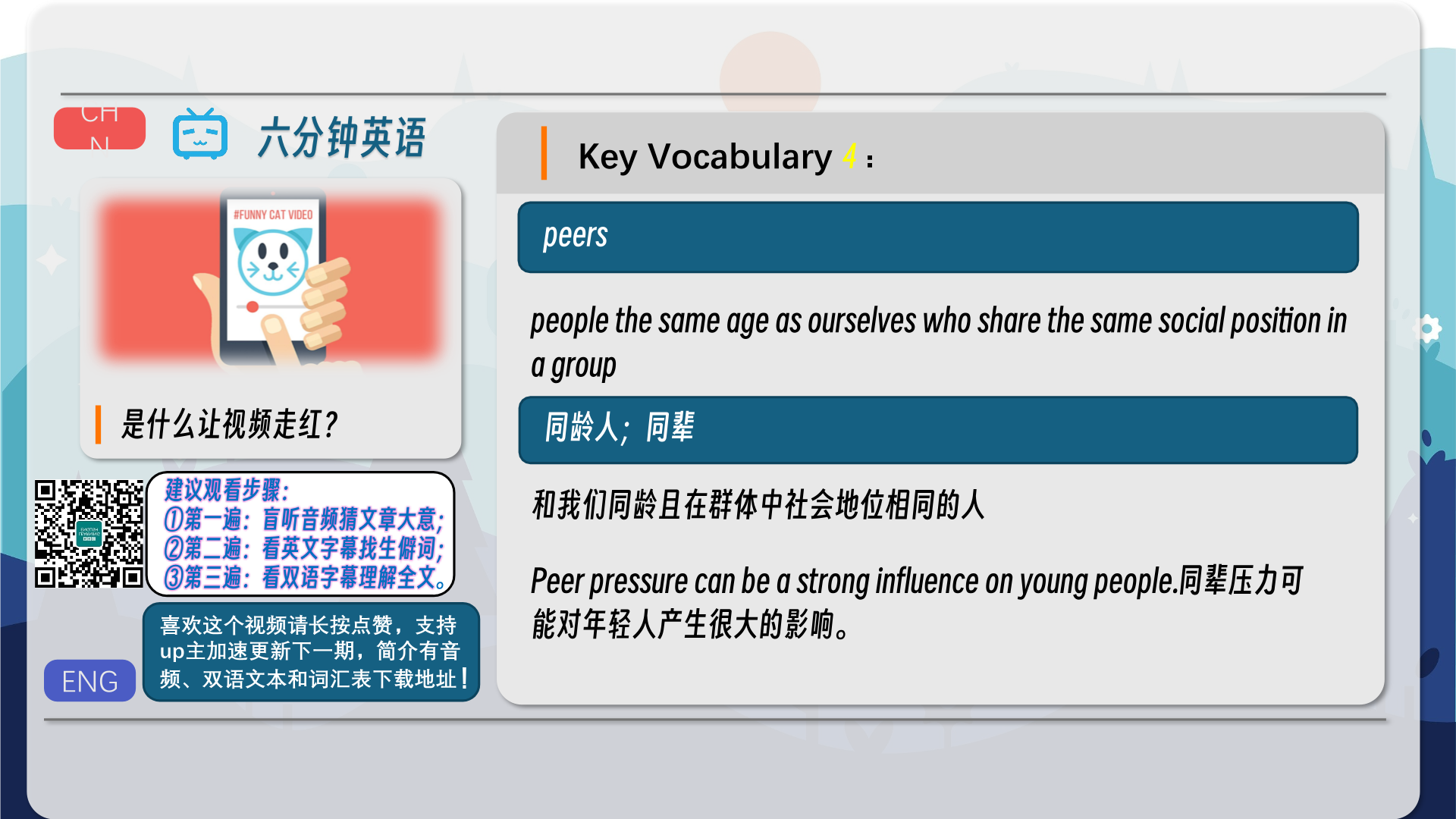



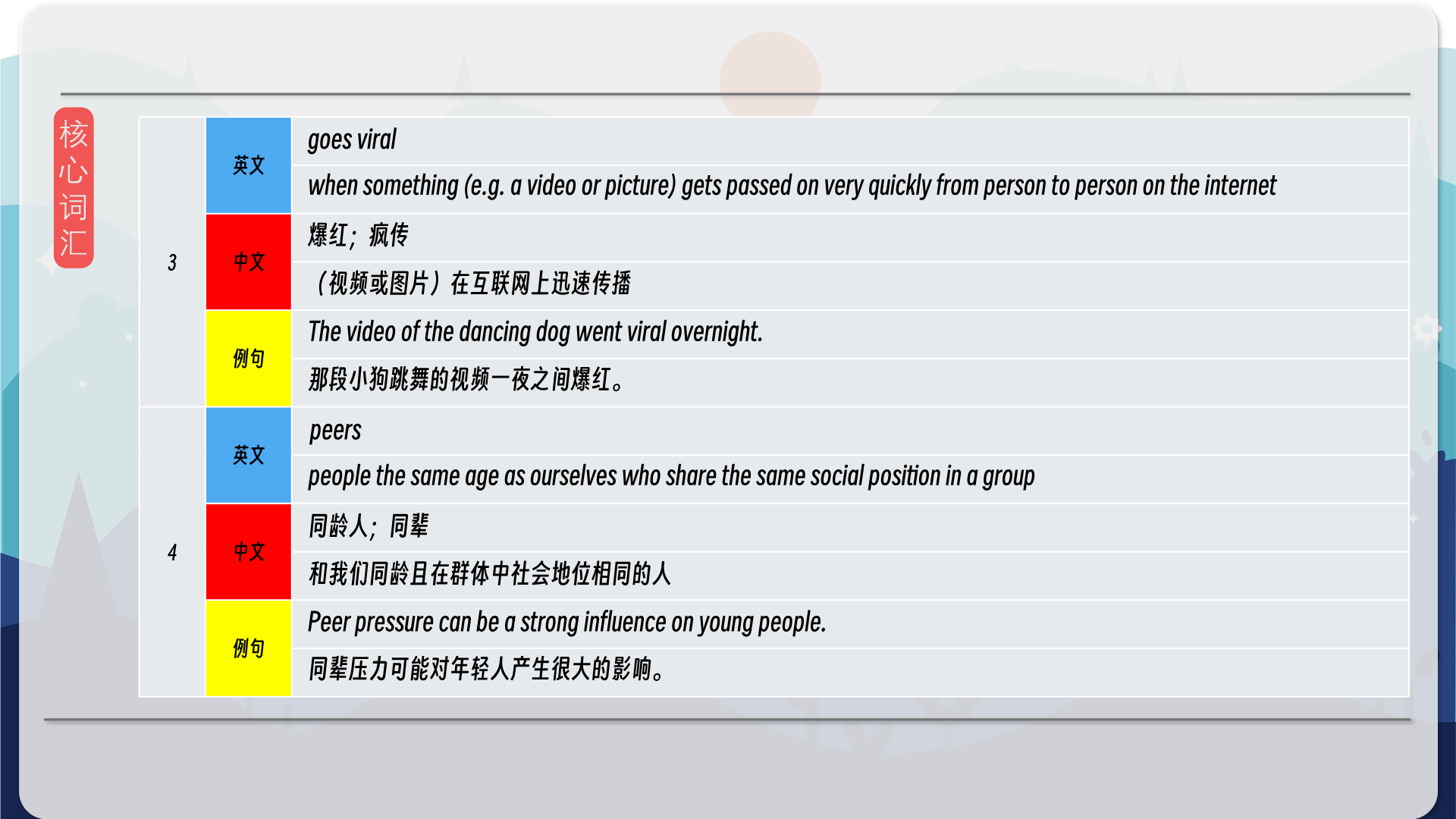
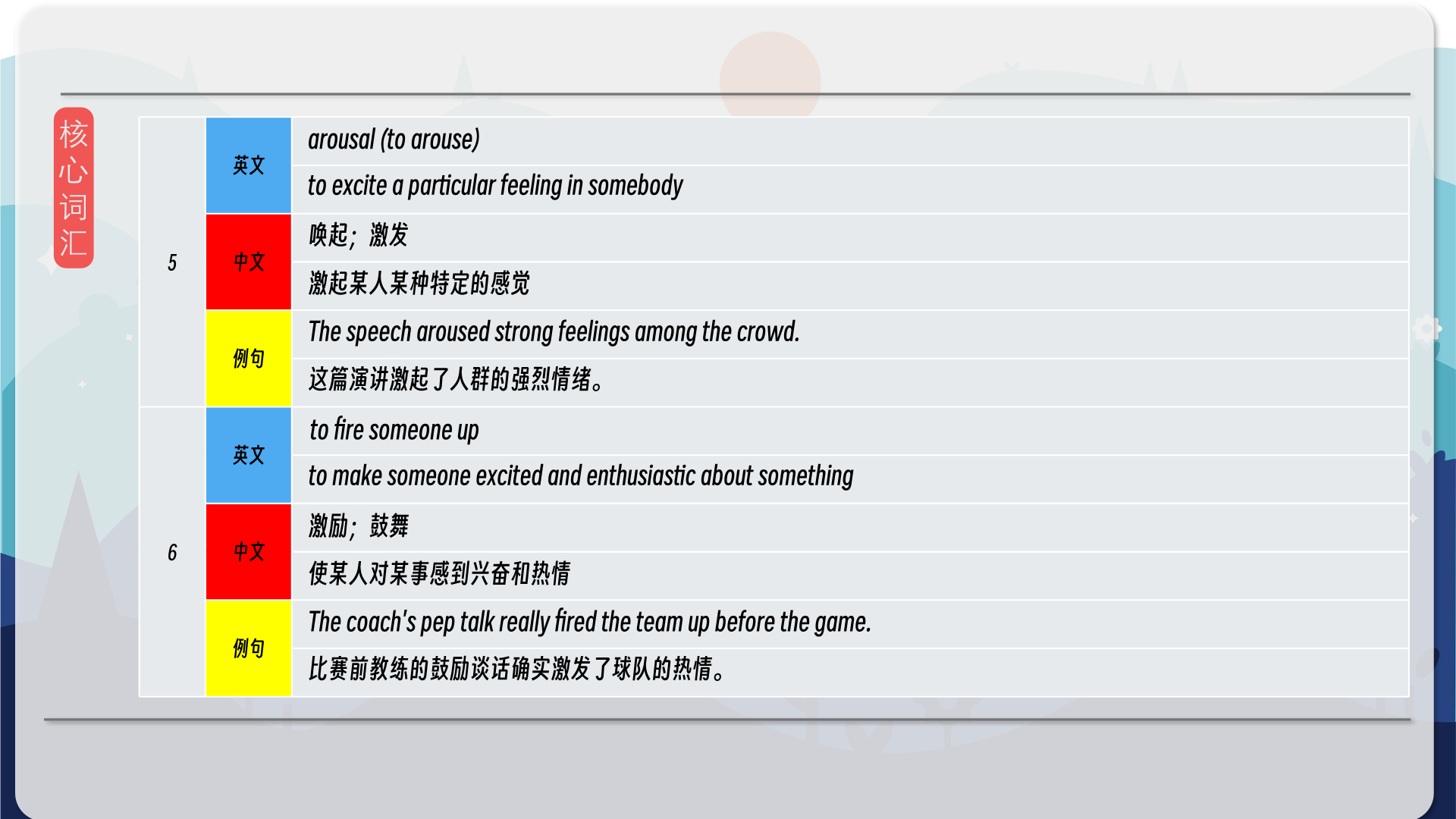
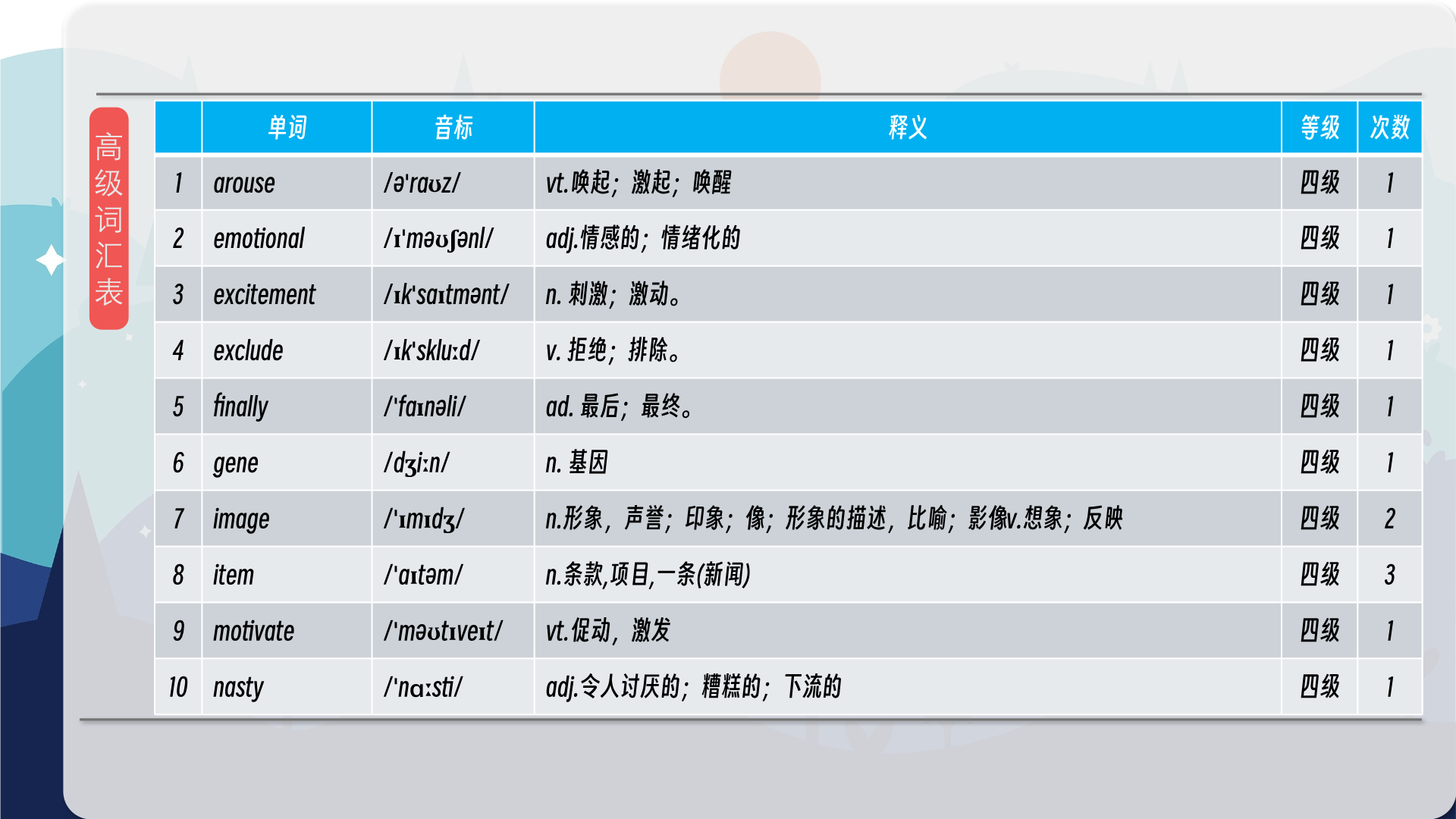
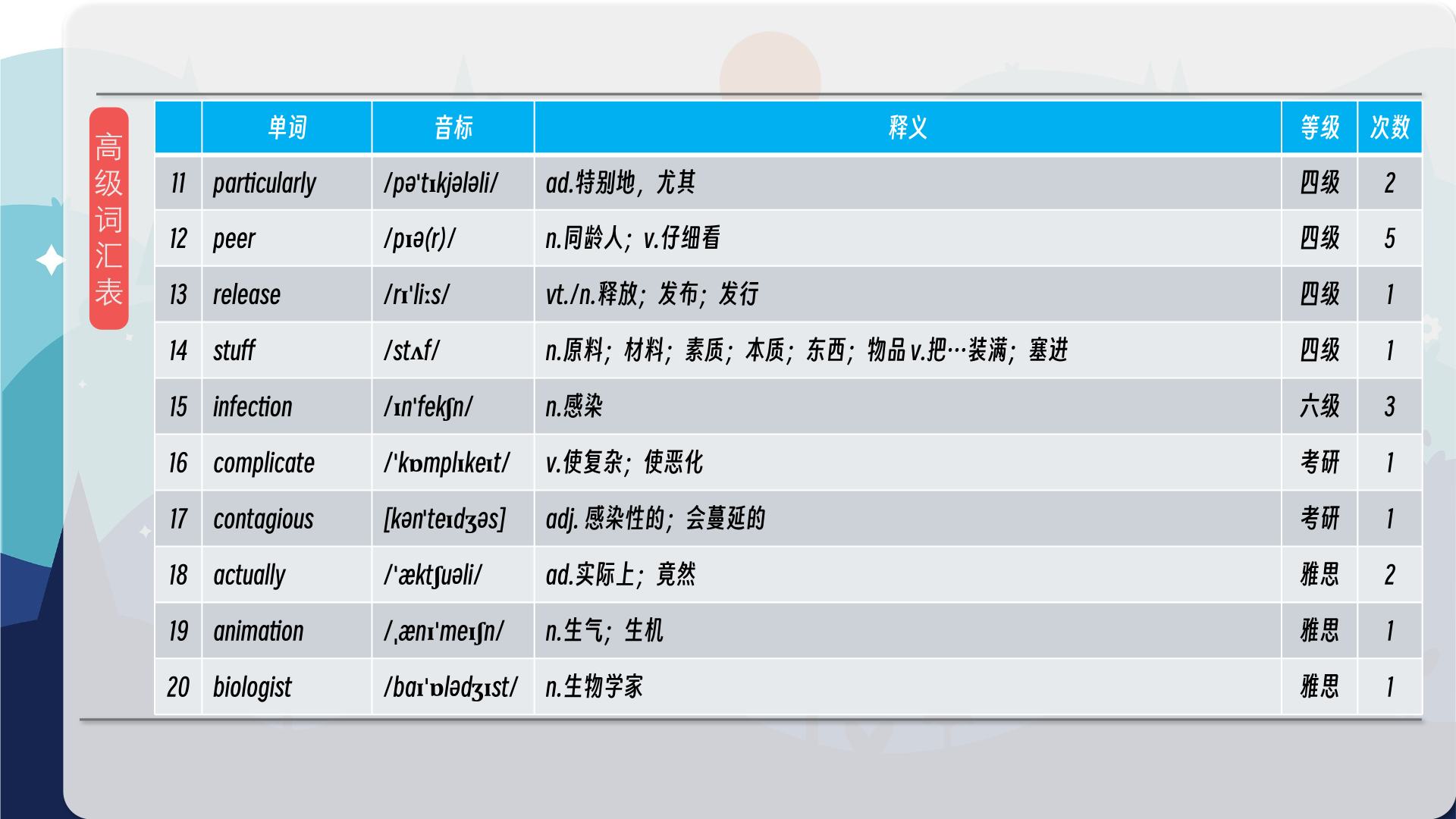
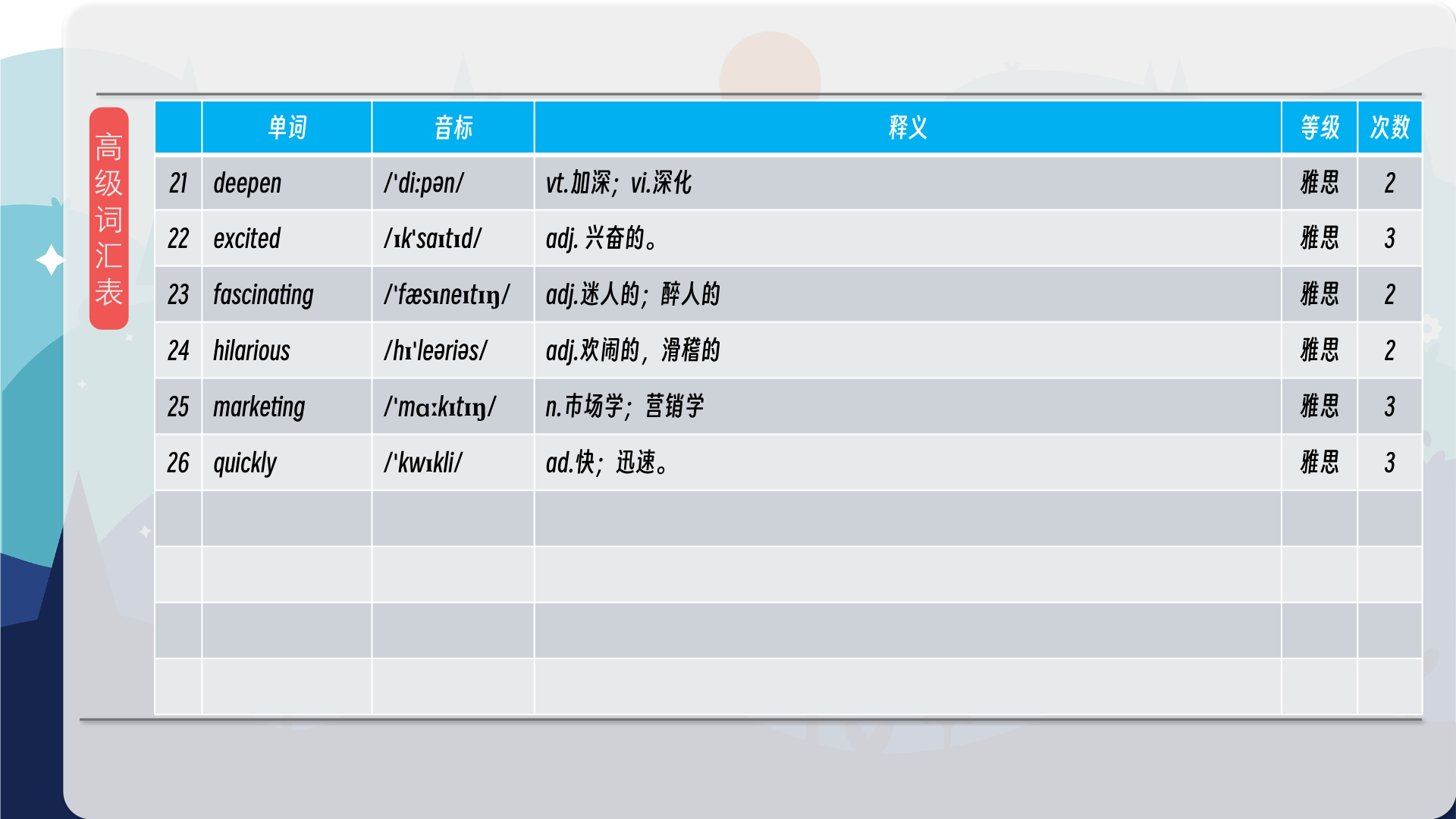

【核心词汇】
meme
a picture or video with an amusing caption that a lot of people share with each other online
迷因;梗图
配有幽默标题的图片或视频,很多人在网上互相分享
This meme of a cat playing the piano has gone viral.
这张猫弹钢琴的梗图已经走红网络。
grumpy
bad tempered!
坏脾气的
脾气暴躁的;不高兴的
He’s always grumpy in the morning.
他早上总是脾气不好。
goes viral
when something (e.g. a video or picture) gets passed on very quickly from person to person on the internet
爆红;疯传
(视频或图片)在互联网上迅速传播
The video of the dancing dog went viral overnight.
那段小狗跳舞的视频一夜之间爆红。
peers
people the same age as ourselves who share the same social position in a group
同龄人;同辈
和我们同龄且在群体中社会地位相同的人
Peer pressure can be a strong influence on young people.
同辈压力可能对年轻人产生很大的影响。
arousal (to arouse)
to excite a particular feeling in somebody
唤起;激发
激起某人某种特定的感觉
The speech aroused strong feelings among the crowd.
这篇演讲激起了人群的强烈情绪。
to fire someone up
to make someone excited and enthusiastic about something
激励;鼓舞
使某人对某事感到兴奋和热情
The coach’s pep talk really fired the team up before the game.
比赛前教练的鼓励谈话确实激发了球队的热情。
在公众号里输入6位数字,获取【对话音频、英文文本、中文翻译、核心词汇和高级词汇表】电子档,6位数字【暗号】在文章的最后一张图片,如【220728】,表示22年7月28日这一期。公众号没有的文章说明还没有制作相关资料。年度合集在B站【六分钟英语】工房获取,每年共计300+文档,感谢支持!